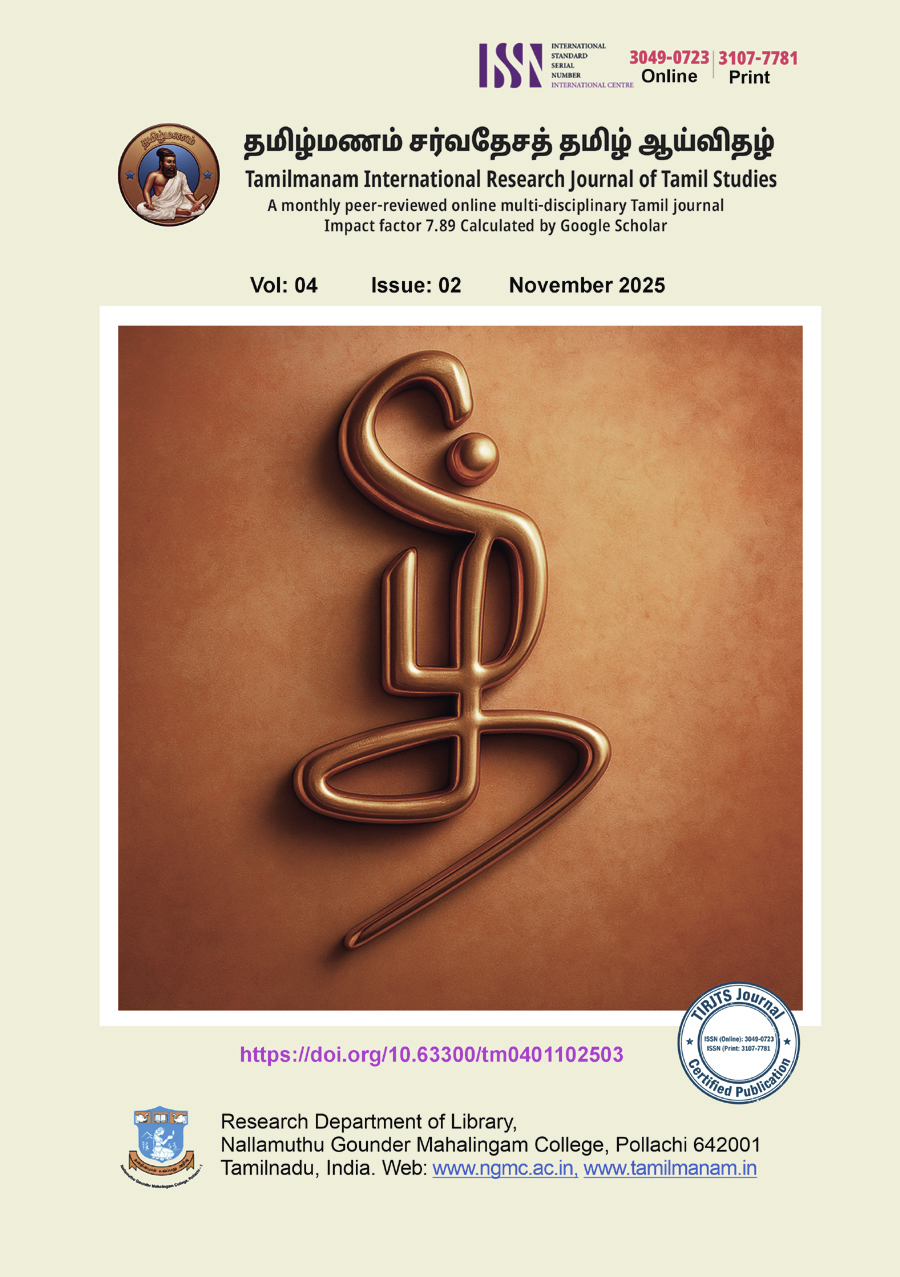துளசி மூலிகையின் ஆன்மீக – மருத்துவ இரட்டை பாதை: சித்தர் வாக்கியங்களில் ஆய்வு
The Dual Path of Tulsi Herb: Spiritual and Medicinal Perspectives in Siddhar Sayings – A Study
DOI:
https://doi.org/10.63300/tm0402112518Keywords:
Tulsi, Siddhar Texts, Spiritual Tradition, Medicinal Use, Phytochemistry, ImmunomodulationAbstract
Tulsi (Ocimum sanctum / Ocimum tenuiflorum) is a vital herb deeply rooted in the Siddha medicine and spiritual traditions of the Tamils. This study examines the spiritual significance of Tulsi as described in Siddhar texts and how this traditional perspective is embedded in its medicinal applications. In the Siddha tradition, Tulsi is considered a sacred plant possessing a Sattvic nature, believed to have the power to purify the mind and the environment. Parallel to this spiritual concept, Siddha literature extensively documents medicinal remedies for various health issues, including common colds, respiratory problems, skin diseases, and digestive disorders.
This article explores this historical-social connection and seeks to validate the medicinal advice of the Siddhars using modern scientific evidence. The phytochemical analysis of Tulsi reveals a wealth of nutrients and biological compounds. Modern studies have confirmed that Tulsi possesses various therapeutic properties, such as immunomodulatory, antimicrobial, adaptogenic (stress-relieving), and antioxidant effects. This study integrates Siddhar texts, their translations, and contemporary pharmacological, technological, and clinical trial research.
In conclusion, this dual perspective—where the spiritual and medicinal aspects of Siddha medicine intersect—aligns with modern scientific findings in many instances. However, some aspects of the Siddha concepts highlight their empirical approach and the need for a context-appropriate explanation. By scientifically verifying a traditional knowledge system, this research underscores the holistic medicinal value of Tulsi.
துளசி (Ocimum sanctum / Ocimum tenuiflorum) என்பது தமிழரின் சித்த மருத்துவ மற்றும் ஆன்மீகப் பாரம்பரியத்தில் ஆழமாக வேரூன்றியுள்ள ஒரு முக்கிய மூலிகையாகும். இந்த ஆய்வானது, சித்தர் நூல்களில் விவரிக்கப்பட்டுள்ள துளசியின் ஆன்மீக முக்கியத்துவத்தையும், அந்தப் பாரம்பரியப் பார்வை அதன் மருத்துவப் பயன்பாடுகளில் எவ்வாறு உறைந்துள்ளது என்பதையும் ஆய்வுக்கு எடுத்துக்கொள்கிறது. சித்த மரபில், துளசி ஒரு சாத்வீகமான தன்மை கொண்ட புனிதச் செடியாகக் கருதப்படுகிறது, மனதையும் சூழலையும் சுத்திகரிக்கும் திறன் கொண்டதாக நம்பப்படுகிறது. இந்த ஆன்மீகக் கருத்துக்கு இணையாக, சித்த நூல்கள் சளி, சுவாசப் பிரச்சினைகள், தோல் நோய்கள், செரிமானக் கோளாறுகள் உள்ளிட்ட பல்வேறு உடல்நலப் பிரச்சினைகளுக்கான மருத்துவ முறைகளையும் விரிவாகப் பதிவு செய்துள்ளன.
இந்த வரலாற்று-சமூகத் தொடர்பை ஆராயும் இக்கட்டுரை, நவீன அறிவியல் ஆதாரங்களைக் கொண்டு சித்தர்களின் இந்த மருத்துவ அறிவுரைகளை மெய்ப்பிக்க முயல்கிறது. துளசியின் தாவர வேதியியல் (Phytochemistry) பகுப்பாய்வு, அதில் நிறைந்துள்ள சத்துக்கள் மற்றும் உயிரியல் சேர்மங்களை வெளிப்படுத்துகிறது. நவீன ஆய்வுகள், துளசிக்கு நோயெதிர்ப்புத் திறனைக் கட்டுப்படுத்தும் (Immunomodulatory), நுண்ணுயிர் எதிர்ப்பு (Antimicrobial), மன அழுத்தத்தைத் தாங்கும் (Adaptogenic) மற்றும் ஆக்ஸிஜன் எதிர்ப்பு சக்தி (Antioxidant) போன்ற பல்வேறு மருத்துவ குணங்கள் உள்ளன என உறுதிப்படுத்தியுள்ளன. இந்த ஆய்வு, சித்த நூல்கள், அவற்றின் மொழிபெயர்ப்புகள் மற்றும் சமகால மருந்தியல், நுட்பவியல் மற்றும் மருத்துவ ஆய்வுகள் (Clinical trials) ஆகியவற்றை ஒருங்கிணைத்து முன்வைக்கிறது.
முடிவாக, சித்த மருத்துவத்தின் ஆன்மீகம் மற்றும் மருத்துவம் சந்திக்கும் இந்த இருமுகப் பார்வை, பல இடங்களில் நவீன அறிவியல் கண்டுபிடிப்புகளுடன் இசைகிறது. இருப்பினும், சித்தக் கருத்துகளின் சில அம்சங்கள், அனுபவ அடிப்படையிலான (Empirical) அவர்களின் அணுகுமுறை மற்றும் காலத்திற் கேற்ற விளக்கத்தின் தேவை ஆகியவற்றை எடுத்துக்காட்டுகின்றன. இந்த ஆய்வு, ஒரு பாரம்பரிய அறிவு முறையை அறிவியல் ரீதியாகச் சரிபார்ப்பதன் மூலம், துளசியின் முழுமையான மருத்துவ மதிப்பை வலியுறுத்துகிறது.
Downloads
References
1. Pattanayak, P., et al. (2010). Ocimum sanctum Linn. A reservoir plant for therapeutic applications: An overview. Pharmacognosy Reviews.
2. Cohen, M. M. (2014). Tulsi - Ocimum sanctum: A herb for all reasons. Journal of Ayurveda and Integrative Medicine.
3. Prakash, P., & Gupta, N. (2005). Therapeutic uses of Ocimum sanctum Linn (Tulsi) with a note on eugenol and its pharmacological actions: A short review. Indian Journal of Physiology and Pharmacology.
4. Saxena, R. C., et al. (2012). Efficacy of an extract of Ocimum sanctum in experimental models of stress. Pharmacology Biochemistry and Behavior.
5. Shanmugavelu, M. (No Date). Siddhar Vaidya Thirattu (Compilation of Siddha Formulations). Department of Indian Medicine and Homeopathy.
6. Govindan, S. V. (2005). Fundamentals of Siddha Medicine. Department of Indian Medicine and Homeopathy.
7. Pandey, G., & Madhuri, S. (2010). Pharmacological activities of Ocimum sanctum (tulsi): a review. International Journal of Pharmaceutical Sciences Review and Research.
8. Cohen, M. M. (2014). Tulsi - Ocimum sanctum: A herb for all reasons. Journal of Ayurveda and Integrative Medicine.
9. Saxena, R. C., et al. (2012). Efficacy of an extract of Ocimum sanctum in experimental models of stress. Pharmacology Biochemistry and Behavior.
10. Balkrishna, A., et al. (2021). Anti-SARS-CoV-2 phytotherapeutic promise of Tulsi: Molecular docking and simulation analysis. Journal of Biomolecular Structure and Dynamics.
11. Jamshidi, N., & Cohen, M. M. (2017). The Clinical Efficacy and Safety of Tulsi in Humans: A Systematic Review of the Literature. Evidence-Based Complementary and Alternative Medicine.
12. Jamshidi, N., & Cohen, M. M. (2017). The Clinical Efficacy and Safety of Tulsi in Humans: A Systematic Review of the Literature. Evidence-Based Complementary and Alternative Medicine.
13. Mondal, S., et al. (2023). Herb-Drug Interactions of Common Herbal Medicines: A Narrative Review. Journal of Ethnopharmacology.
Downloads
Published
Issue
Section
License
Copyright (c) 2025 Dr. D. Dhinesh, Dr. V.C. Srinivasan, Dr. A. Lakshmi Duttai (Author)

This work is licensed under a Creative Commons Attribution 4.0 International License.
Our journal adopts CC BY License Creative Commons Attribution 4.0 International License http://Creativecommons.org//license/by/4.0/ . It allows using, reusing, distributing and reproducing of the original work with proper citation.


